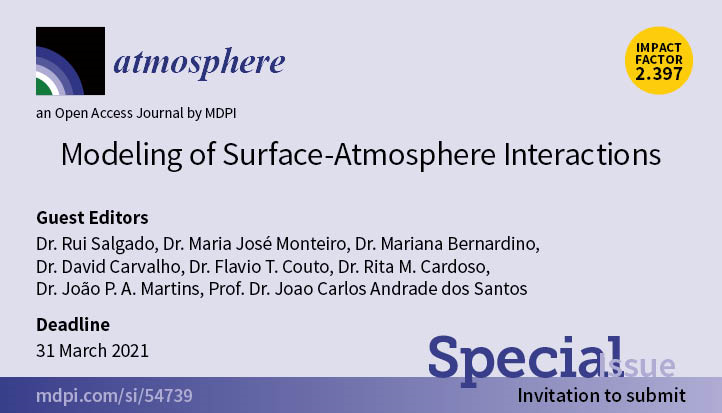Dr. Maria José Monteiro
Dr. Mariana Bernardino
Dr. David Carvalho
Dr. Flavio T. Couto
Dr. Rita M. Cardoso
Dr. João P. A. Martins
Prof. Dr. Joao Carlos Andrade dos Santos
Along with numerical weather prediction (NWP) progress in the past couple of decades, challenges remain as a result of the increasing complexity of today’s models. For instance, the representation of the land surface has evolved tremendously. An accurate representation of the exchanges of energy, mass (including water, desert dust, carbon, and greenhouse gases), and momentum is essential for better quality forecasts, especially for processes in the lower levels of the atmosphere. These exchanges involve a thorough description of the processes linked to turbulence, vegetation dynamics and physiological processes, precipitation and snow, surface energy balance, orographic processes, river discharge and runoff, anthropogenic forcing, etc.Surface modeling (including land, ocean, inland water, urban areas, ice, and snow) is crucial for accurate numerical weather predictions and for the understanding and modeling of climate change. The latest Intergovernmental Panel on Climate Change (IPCC) reports are clear regarding the effects of climate change across the Mediterranean, in particular across Iberia, and consider this region a hotspot for climate change. The effects include increased risk of droughts, wildfires, extreme events (such as floods and heat waves), and coastal flooding due to increased mean sea level and storm severity.
Accurate observations (in situ, satellite, and others) are crucial to improve these models. In the 2018 Statement of Guidance for High-Resolution Numerical Weather Prediction, the World Meteorological Organization recommended that the planning of future conventional networks should focus on the boundary layer, as this is where NWP vertical resolution is highest. In particular, the density and frequency of observations available from the Mediterranean Sea should be expanded. A number of new satellite sensors and products have allowed better diagnostics of model biases. For instance, the Satellite Application Facility on Land Surface Analysis (which is part of the ground segment of the European Organisation for the Exploitation of Meteorological Satellites (EUMETSAT) based at the IPMA, Portugal) provides a portfolio of satellite-derived land surface variables related to the surface energy balance and vegetation state.
Data assimilation systems combine modeling and observational techniques to provide more realistic products. These techniques are in use by several international agencies, such as NASA, ECMWF, ESA, and Météo-France. For instance, the ECMWF used this capacity to produce ERA5-Land, a global reanalysis with relatively high resolution (~9 km) with data every hour, available from 1981 onward. Ocean, surface wind, and sea state information are assimilated into atmospheric and ocean models (waves, currents, sea surface temperature and height, etc.) to produce accurate forecasts and reanalysis datasets. Finally, all major global and limited area models represent surface processes using a dedicated scheme.
This Special Issue launched in the framework of the workshop on “Numerical Weather Prediction in Portugal 2020” (https://sites.google.com/
Modeling development, test, and validation;
Surface observations and data assimilation;
Surface reanalysis;
Land–atmosphere interactions and feedback;
Atmosphere–ocean interactions;
Cryosphere–atmosphere interactions;
Inland waters–atmosphere interactions;
Boundary layer processes and modeling;
Urban boundary layer;
Atmospheric circulations over complex terrain;
Land use and climate change;
Fire–weather interactions and modeling;
Dust mobilization;
Transfer of greenhouse gases at the surface–atmosphere interface;
Emission of pollen into the atmosphere.
More information here.

